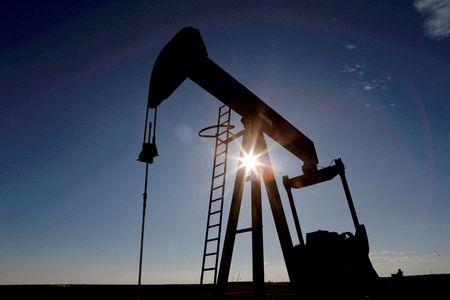By Arathy Somasekhar and Liz Hampton
(Reuters) -Rising costs and shortages of labor and materials have plagued U.S. shale oil production all year, and in the waning days of 2022, more energy executives are saying those may even worsen in 2023.
From Texas to North Dakota, executives have warned on fourth quarter output, trimmed full-year production forecasts, or pinned expected gains at the low-end of earlier estimates even as higher oil and gas prices support profits.
The U.S. government on Tuesday slashed its oil production projection for 2023 by a whopping 21% following a string of disappointing forecasts from the shale patch.
Oil producer Diamondback Energy on Tuesday told investors shale production gains are likely to remain subdued in the coming years. It blamed aging wells, supply chain bottlenecks and an unblinking investor focus on shareholder returns.
ConocoPhillips had a similar sobering message earlier this month.
“Rapidly escalating costs combined with extremely tight supply are limiting the pace of industry-wide production growth,” chief executive Ryan Lance said in an earnings call.
Conoco, the largest independent U.S. oil producer, forecast overall production growth of about 900,000 barrels per day this year, but warned that gains would slow in 2023 on unrelenting oilfield inflation.
Diamondback Chief Executive Officer Travis Stice said the top U.S. shale field has stretched to volumes of between 5.3 million to 5.5 million barrels per day. But the industry “is going to be challenged to continue to grow that into the future,” Stice told investors on Tuesday.
Weak U.S. oil output growth has put the fossil fuel industry in Washington’s cross-hairs. President Joe Biden has criticized companies for not lifting production faster and raking in massive profits as energy inflation hits consumers.
“It certainly seems like the rhetoric has turned decidedly against the industry again in the lead up to these elections,” said Stice, referring to Nov. 8 mid-term elections to Congress.
Occidental Petroleum, Ovintiv and Northern Oil & Gas are all due to present results and production outlooks later on Tuesday. Occidental CEO Vicki Hollub earlier this year said lingering effects of pandemic cutbacks were underappreciated by investors.
Unlike earlier shale rebounds that brought robust volume gains, subdued output gains look set to remain the norm this time. Diamondback anticipates its 2023 production will rise at a low single-digit percentage rate. Rival Pioneer Natural Resources said it had faced lower-than-anticipated productivity on some wells in west Texas and would revise its drilling plan for next year.
SM Energy recently trimmed its 2022 forecast by 3%, blaming shut-ins and supply chain shortages that delayed well completions. Rival Laredo Petroleum forecast lower fourth-quarter production compared to the third.
A recurring issue for many companies is aging oil wells, where production declines rapidly, and the detrimental impact of wells drilled too closely together on productivity.
Coterra Energy, created by a merger of Cimarex Energy and Cabot Oil & Gas, last week slashed its reserves, a key to future production, citing the impact of secondary wells that can hurt volumes.
(Reporting by Arathy Somasekhar in Bangalore and Liz Hampton in DenverEditing by Tomasz Janowski)


